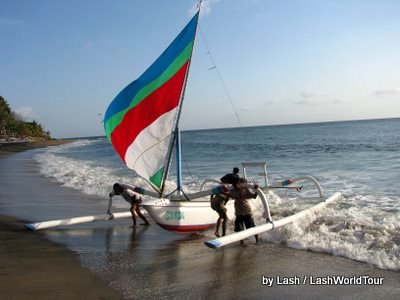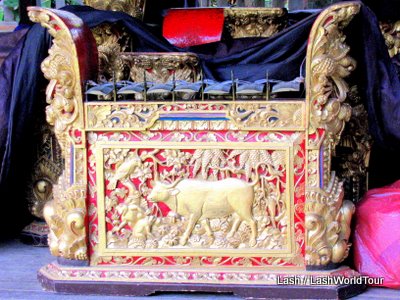| pouring arak for a friend |
BALI ARAK AND TUAK: BALI’S LOCALLY BREWED “MOONSHINE”
Most S.E.Asian countries have some form of locally brewed ‘hard stuff.’ In Asia such brews are usually made from rice or palm juice. Bali’s two local drinks are made from palm tree fruits. Arak is the more famous brew, known even by tourists because it’s often served in 5-star resorts and hotels in Bali. At resorts and tourist restaurants arak is usually served as a cocktail, the two most popular being ‘Arak Madu’ (arak with honey) and ‘Arak Attack’ (arak with sprite and lemon)
Arak is also an integral part of daily Balinese life. It’s served at various ceremonies including funerals, weddings, and numerous Hindu ceremonies. In addition, local guys often drink arak in the evenings with friends, either at a bar, a friend’s house, or outside along the street. In rural areas like Amed in NE Bali, it’s quite common to find groups of guys sitting around roadside or in a public pavilion drinking arak and talking loudly- often yelling excitedly- as they become more and more inebriated. Please note I said ‘guys.’ Balinese girls do not drink or smoke. Drinking is done entirely by ‘the men.’ Forget our western notions of going out for a drink with a girlfriend or wife. The same is true for going out dancing or visiting bars. You won’t find local women in bars dancing. Guys go out. Women stay home. ho-hum.
| Lipah friend drinking arak at funeral |
Someone inevitably produces a single cup. Arak is poured into the communal cup and passed to each person in turn. Everyone sits around chatting and joking, taking their swig of arak in turn. Locals always swill it back in one big gulp. When I join their drinking groups they get annoyed with me because I slowly sip my portion. They get impatient waiting but more importantly, they want me to slug it back like the guys. Local Balinese are pretty pushy/ controlling with each other anyhow. I just ignore their entreaties and drink at my own slow pace. Arak is so potent so it doesn’t take long to get tipsy then outright drunk. Soon everyone is yelling, laughing loudly and generally acting obnoxious. Good fun for all.
Tuak is the less known brew, but is quite popular among locals in rural areas. It’s made from the same palm juice as arak. In fact, It’s made simultaneously with arak. Unlike arak, tuak is a milky fermented rather sour tasting drink which, for some odd reason, is often drunk midday rather than at nighttime. Tuak is even cheaper than arak, but doesn’t stay fresh long. It must be drunk the day it’s made.
|
tuak |
| In places like Lipah village and other Amed communities local guys often sit around a pavilion from late morning to late afternoon, in the burning tropical heat, swilling milky tuak from a big pot. By 4pm, if not earlier, they’re quite toasted. They drink tuak communally like arak, passing around a single cup to each person in turn. Local guys commonly spend half their waking hours drunk, either on tuak, arak, or both. They have lots of spare time. Rather than using it constructively on activities like reading, learning new skills, home improvement, quality time with the wife and kids, or exercise they prefer spending their free time drinking and chattering. They’re laid-back people. |
While living in Amed, drinking arak and observing local guys get toasted on tuak midday, I became quite curious about arak/tuak production. It didn’t take long to hear about a distillery not far from Lipah that makes both. A local friend took me over one day to learn more and photograph the distillation process…
| palm tree used to make arak and tuak |
In the meantime, I started hearing whisperings that both tuak and arak are illegal. Bootleg. I was told it’s illegal to make, buy, sell, possess, and drink the stuff. WHAT? How could that be? I’d been drinking arak regularly the past few months. It’s sold openly at a few local shops. Everyone sits around outside drinking both brews. And it’s sold in restaurants all over Bali. I was quite alarmed at the notion it was illegal. So in addition to observing the distillation process I also set out to learn the truth about this ‘bootleg’ brewing.
I also learned the distillation process for tuak and arak:
* Palm tree fruits are split open, the juice extracted.
* Palm juice is poured into containers, which are placed above open flames. The juice is boiled.
* Bamboo pipes are fastened to the tops of the containers. Steam runs up the pipes then drips down into bottles. This is arak.
* Boiled juice remaining in the original ‘cooking pots’ becomes tuak. (see black bucket above)
| arak brewing |
Pretty simple. I learned there are 4 grades of arak, 1 being the ‘most pure’ and ‘cleanest.’ #1 arak is actually as clear as water. #2 arak looks a bit yellowish. #3 and 4 are even less ‘pure.’ You can certainly taste the difference. Grade #1 is much smoother.
If you visit Bali, be sure to try some arak, both the restaurant cocktail variety and the local’s blend. Then get a swig of tuak from a bucket one afternoon in a rural village. It’s sure to curl your toes!!
Lash
You might also like:
Gamelan: Bali’s Traditional Percussion Orchestras
Life of a Mackerel Fisherman in Amed
Salt Making in Amed
Photo Gallery: Rural Life in Amed
Photo Gallery: Balinese Ceremonies
———————————————————————————————————————————————–












 Hi! I'm Lash, an American nomadic world traveler who's been traveling solo since 1998. I’m passionate about traveling the world nomadically and then sharing it all with you. I hope to inspire you to travel the world, to entertain you with tales from the road, and to help you reach your travel dreams. Welcome!
Hi! I'm Lash, an American nomadic world traveler who's been traveling solo since 1998. I’m passionate about traveling the world nomadically and then sharing it all with you. I hope to inspire you to travel the world, to entertain you with tales from the road, and to help you reach your travel dreams. Welcome! 




14 pings
Skip to comment form ↓
BALINESE GAMELAN: BALI'S TRADITIONAL PERCUSSION ORCHESTRAS- LashWorld » LashWorldTour
2012/06/22 at 10:14 am (UTC 8) Link to this comment
[…] What did you think of it? If not, do you think you’d like to? You might also enjoy:Arak and Tuak: Bali’s Locally Brewed MoonshineBalinese Hindu Ceremonies (function() {var s = document.createElement('SCRIPT'), s1 = […]
PHOTO GALLERY: BALINESE STATUES - LashWorldTour » LashWorldTour
2012/07/17 at 11:46 am (UTC 8) Link to this comment
[…] for your garden?Comments much appreciated! Join in the fun… cheers, LashYou might also like:Arak and Tuak, Bali’s Local Moonshine Bali’s Hindu Ceremonies Gamelan, Bali’s Percussion Orchestras var […]
BALI TRAVEL TIPS: 10 Tips and Cautions for Visiting Bali - LashWorldTour » LashWorldTour
2014/02/18 at 2:25 pm (UTC 8) Link to this comment
[…] To learn more about arak read my post: Arak and Tuak, Bali’s Locally Brewed ‘Moonshine’ […]
CULTURAL INSIGHTS: THE 4 BALINESE NAMES - LashWorldTour » LashWorldTour
2014/02/18 at 2:34 pm (UTC 8) Link to this comment
[…] Arak and Tuak: Bali’s Locally Brewed Moonshine […]